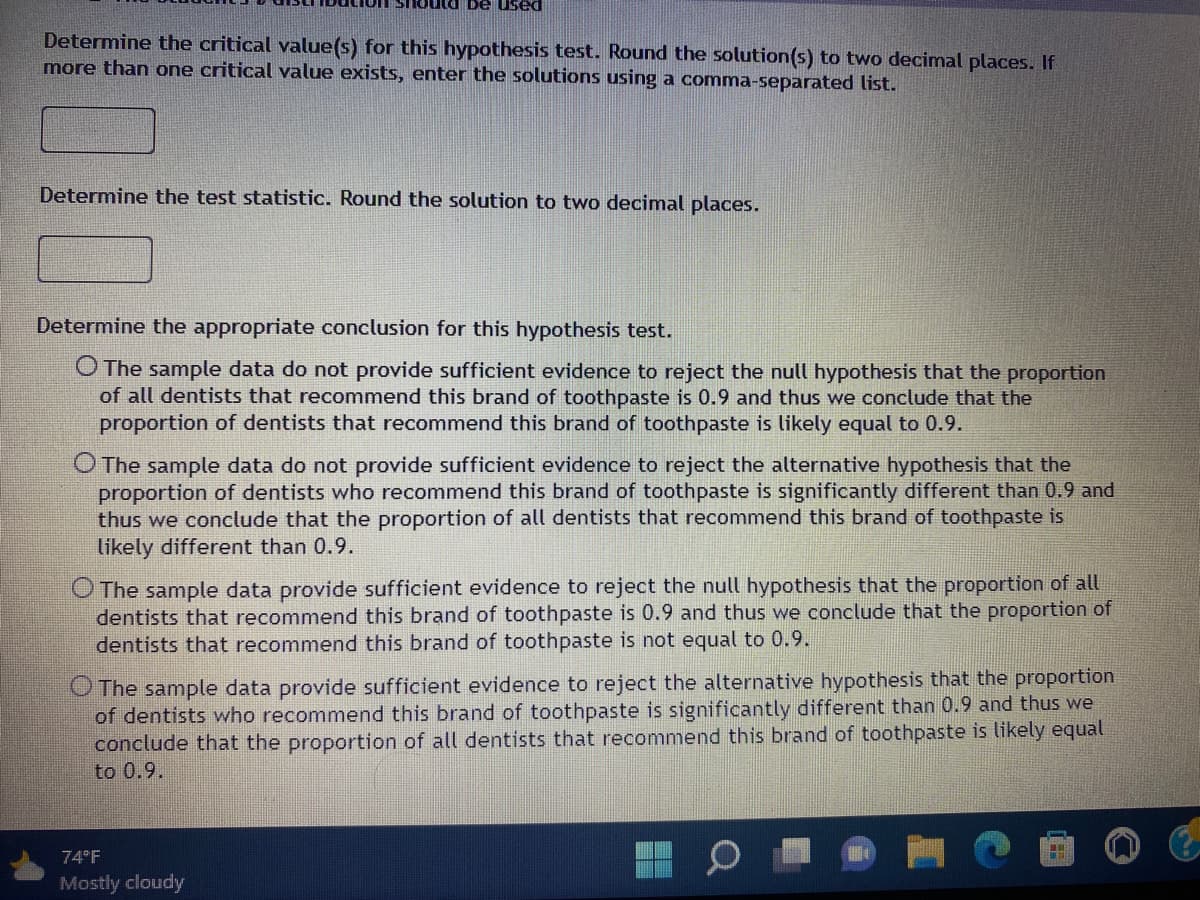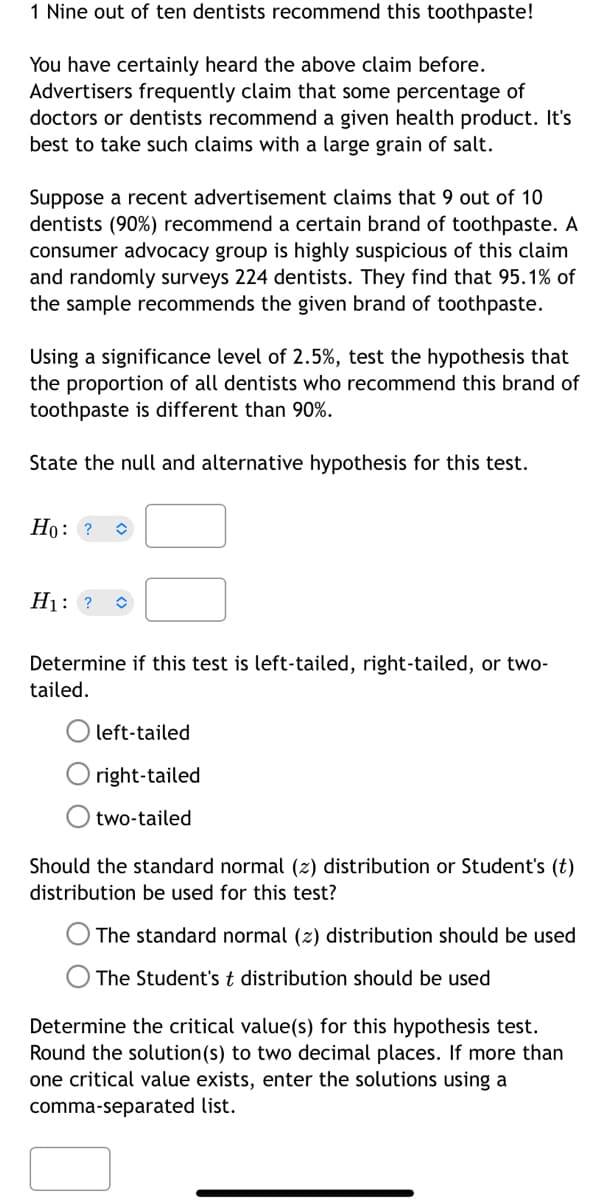should be used Determine the critical value(s) for this hypothesis test. Round the solution(s) to two decimal places. If more than one critical value exists, enter the solutions using a comma-separated list. Determine the test statistic. Round the solution to two decimal places. Determine the appropriate conclusion for this hypothesis test. O The sample data do not provide sufficient evidence to reject the null hypothesis that the propor of all dentists that recommend this brand of toothpaste is 0.9 and thus we conclude that the proportion of dentists that recommend this brand of toothpaste is likely equal to 0.9. O The sample data do not provide sufficient evidence to reject the alternative hypothesis that the proportion of dentists who recommend this brand of toothpaste is significantly different than 0. thus we conclude that the proportion of all dentists that recommend this brand of toothpaste is likely different than 0.9. O The sample data provide sufficient evidence to reject the null hypothesis that the proportion o dentists that recommend this brand of toothpaste is 0.9 and thus we conclude that the proporti dentists that recommend this brand of toothpaste is not equal to 0.9. O The sample data provide sufficient evidence to reject the alternative hypothesis that the propo of dentists who recommend this brand of toothpaste is significantly different than 0.9 and thus conclude that the proportion of all dentists that recommend this brand of toothpaste is likely e to 0.9. 74°F O
should be used Determine the critical value(s) for this hypothesis test. Round the solution(s) to two decimal places. If more than one critical value exists, enter the solutions using a comma-separated list. Determine the test statistic. Round the solution to two decimal places. Determine the appropriate conclusion for this hypothesis test. O The sample data do not provide sufficient evidence to reject the null hypothesis that the propor of all dentists that recommend this brand of toothpaste is 0.9 and thus we conclude that the proportion of dentists that recommend this brand of toothpaste is likely equal to 0.9. O The sample data do not provide sufficient evidence to reject the alternative hypothesis that the proportion of dentists who recommend this brand of toothpaste is significantly different than 0. thus we conclude that the proportion of all dentists that recommend this brand of toothpaste is likely different than 0.9. O The sample data provide sufficient evidence to reject the null hypothesis that the proportion o dentists that recommend this brand of toothpaste is 0.9 and thus we conclude that the proporti dentists that recommend this brand of toothpaste is not equal to 0.9. O The sample data provide sufficient evidence to reject the alternative hypothesis that the propo of dentists who recommend this brand of toothpaste is significantly different than 0.9 and thus conclude that the proportion of all dentists that recommend this brand of toothpaste is likely e to 0.9. 74°F O
Holt Mcdougal Larson Pre-algebra: Student Edition 2012
1st Edition
ISBN:9780547587776
Author:HOLT MCDOUGAL
Publisher:HOLT MCDOUGAL
Chapter11: Data Analysis And Probability
Section: Chapter Questions
Problem 8CR
Related questions
Question
100%

Transcribed Image Text:should be used
Determine the critical value(s) for this hypothesis test. Round the solution(s) to two decimal places. If
more than one critical value exists, enter the solutions using a comma-separated list.
Determine the test statistic. Round the solution to two decimal places.
Determine the appropriate conclusion for this hypothesis test.
O The sample data do not provide sufficient evidence to reject the null hypothesis that the proportion
of all dentists that recommend this brand of toothpaste is 0.9 and thus we conclude that the
proportion of dentists that recommend this brand of toothpaste is likely equal to 0.9.
O The sample data do not provide sufficient evidence to reject the alternative hypothesis that the
proportion of dentists who recommend this brand of toothpaste is significantly different than 0.9 and
thus we conclude that the proportion of all dentists that recommend this brand of toothpaste is
likely different than 0.9.
O The sample data provide sufficient evidence to reject the null hypothesis that the proportion of all
dentists that recommend this brand of toothpaste is 0.9 and thus we conclude that the proportion of
dentists that recommend this brand of toothpaste is not equal to 0.9.
O The sample data provide sufficient evidence to reject the alternative hypothesis that the proportion
of dentists who recommend this brand of toothpaste is significantly different than 0.9 and thus we
conclude that the proportion of all dentists that recommend this brand of toothpaste is likely equal
to 0.9.
74°F
Mostly cloudy

Transcribed Image Text:1 Nine out of ten dentists recommend this toothpaste!
You have certainly heard the above claim before.
Advertisers frequently claim that some percentage of
doctors or dentists recommend a given health product. It's
best to take such claims with a large grain of salt.
Suppose a recent advertisement claims that 9 out of 10
dentists (90%) recommend a certain brand of toothpaste. A
consumer advocacy group is highly suspicious of this claim
and randomly surveys 224 dentists. They find that 95.1% of
the sample recommends the given brand of toothpaste.
Using a significance level of 2.5%, test the hypothesis that
the proportion of all dentists who recommend this brand of
toothpaste is different than 90%.
State the null and alternative hypothesis for this test.
Ho: ? î
H₁: ? û
Determine if this test is left-tailed, right-tailed, or two-
tailed.
left-tailed
right-tailed
two-tailed
Should the standard normal (z) distribution or Student's (t)
distribution be used for this test?
The standard normal (z) distribution should be used
The Student's t distribution should be used
Determine the critical value(s) for this hypothesis test.
Round the solution (s) to two decimal places. If more than
one critical value exists, enter the solutions using a
comma-separated list.
Expert Solution
This question has been solved!
Explore an expertly crafted, step-by-step solution for a thorough understanding of key concepts.
Step by step
Solved in 2 steps with 2 images

Recommended textbooks for you

Holt Mcdougal Larson Pre-algebra: Student Edition…
Algebra
ISBN:
9780547587776
Author:
HOLT MCDOUGAL
Publisher:
HOLT MCDOUGAL

Holt Mcdougal Larson Pre-algebra: Student Edition…
Algebra
ISBN:
9780547587776
Author:
HOLT MCDOUGAL
Publisher:
HOLT MCDOUGAL